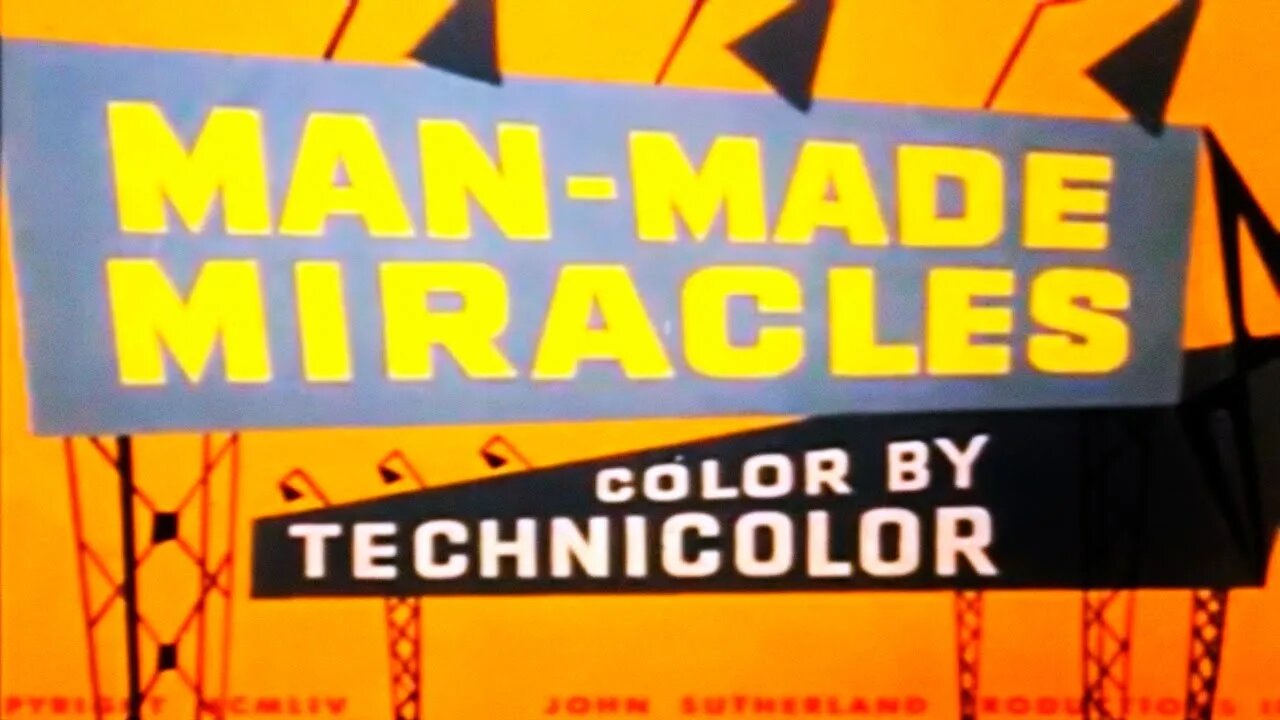Premium Only Content

Man Made Miracles (1954)
Sponsor: Goodrich (B.F.) Company
Producer: John Sutherland Productions
Distribution: United Artists Corporation
Technicolor
Originally a public domain film, slightly cropped to remove uneven edges, with the aspect ratio corrected, and one-pass brightness-contrast-color correction & mild video noise reduction applied.
The soundtrack was also processed with volume normalization, noise reduction, clipping reduction, and/or equalization (the resulting sound, though not perfect, is far less noisy than the original).
A synthetic rubber is any artificial elastomer. These are mainly polymers synthesized from petroleum byproducts. About fifteen billion kilograms (thirty-three billion pounds) of rubbers are produced annually, and of that amount two thirds are synthetic. Global revenues generated with synthetic rubbers are likely to rise to approximately US$56 billion in 2020. Synthetic rubber, like natural rubber, has uses in the automotive industry for tires, door and window profiles, hoses, belts, matting, and flooring...
History of synthetic rubber
The expanded use of bicycles, and particularly their pneumatic tires, starting in the 1890s, created increased demand for rubber. In 1909, a team headed by Fritz Hofmann, working at the Bayer laboratory in Elberfeld, Germany, succeeded in polymerizing isoprene, the first synthetic rubber.
The first rubber polymer synthesized from butadiene was created in 1910 by the Russian scientist Sergei Vasiljevich Lebedev. This form of synthetic rubber provided the basis for the first large-scale commercial production by the tsarist empire, which occurred during World War I as a result of shortages of natural rubber. This early form of synthetic rubber was again replaced with natural rubber after the war ended, but investigations of synthetic rubber continued. Russian American Ivan Ostromislensky who moved to New York in 1922 did significant early research on synthetic rubber and a couple of monomers in the early 20th century. Political problems that resulted from great fluctuations in the cost of natural rubber led to the enactment of the Stevenson Act in 1921. This act essentially created a cartel which supported rubber prices by regulating production, but insufficient supply, especially due to wartime shortages, also led to a search for alternative forms of synthetic rubber.
By 1925 the price of natural rubber had increased to the point that many companies were exploring methods of producing synthetic rubber to compete with natural rubber. In the United States, the investigation focused on different materials than in Europe, building on the early laboratory work of Fr Julius Nieuwland, a professor of chemistry at the University of Notre Dame, who developed the synthesis of neoprene.
Studies published in 1930 written independently by Lebedev, the American Wallace Carothers and the German scientist Hermann Staudinger led in 1931 to one of the first successful synthetic rubbers, known as neoprene, which was developed at DuPont under the direction of E. K. Bolton. Neoprene is highly resistant to heat and chemicals such as oil and gasoline, and is used in fuel hoses and as an insulating material in machinery. The company Thiokol applied their name to a competing type of rubber based on ethylene dichloride, which was commercially available in 1930...
In 1935, German chemists synthesized the first of a series of synthetic rubbers known as Buna rubbers. These were copolymers, meaning the polymers were made up from two monomers in alternating sequence. Other brands included Koroseal, which Waldo Semon developed in 1935, and Sovprene, which Russian researchers created in 1940.
B. F. Goodrich Company scientist Waldo Semon developed a new and cheaper version of synthetic rubber known as Ameripol in 1940. Ameripol made synthetic rubber production much more cost effective...
The production of synthetic rubber in the United States expanded greatly during World War II, since the Axis powers controlled nearly all the world's limited supplies of natural rubber by mid-1942. Military trucks needed rubber for tires, and rubber was used in almost every other war machine. The U.S. government launched a major (and largely secret) effort to improve synthetic rubber production. A large team of chemists from many institutions were involved, including Calvin Souther Fuller of Bell Labs. The rubber designated GRS (Government Rubber Styrene), a copolymer of butadiene and styrene, was the basis for U.S. synthetic rubber production during World War II. By 1944, a total of 50 factories were manufacturing it, pouring out a volume of the material twice that of the world's natural rubber production before the beginning of the war. It still represents about half of total world production...
© John Sutherland Productions
-
 9:36
9:36
Colion Noir
10 hours ago3am TikTok Pranking Teens Get Shot, & Armed Homeowner Is Arrested In Virginia
65.7K72 -
 8:00:02
8:00:02
SpartakusLIVE
11 hours agoThe Spartan and The Dragon take over VERDANSK || Duos w/ Rallied
58.3K3 -
 3:00:03
3:00:03
TheItalianCEO
10 hours agoTHE CRISPIEST Gameplay you'll ever see - 40k bitrate. Let's push RTMP Direct to the limit!
49.3K3 -
 39:44
39:44
Friday Beers
10 hours ago $8.33 earnedWe Drank 12 Beers and Found Malaysian Flight 370
62.5K5 -
 2:41:37
2:41:37
Sgt Wilky Plays
9 hours agoRogue Company Ft Enduendo
48.6K2 -
 20:08
20:08
T-SPLY
15 hours agoDemocrats Fume Over Jake Tapper Exposing Biden Decline!
85.1K46 -
 1:21:14
1:21:14
Glenn Greenwald
12 hours agoRebrand of Syria's al-Jolani: Does the Term "Terrorist" Mean Anything?; "Free Market" Governors Ban Lab-Grown Meats to Protect Meat Industry: With Reason Journalist Emma Camp | SYSTEM UPDATE SHOW #455
237K149 -
 37:51
37:51
Sean Unpaved
11 hours agoFirst & Goal: 2025 NFL Schedule Breakdown & Rivalries to Watch
55.1K2 -
 2:25:48
2:25:48
megimu32
9 hours agoON THE SUBJECT: Dress Codes, Cereal Toys & Why Gen Z Is Too Soft
26K9 -
 6:04:54
6:04:54
VOPUSARADIO
14 hours agoPOLITI-SHOCK! "HARSH TRUTHS FOR A BRIGHTER FUTURE"!
17.3K